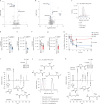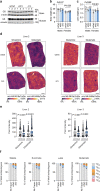Hepatic glutamine synthetase controls N5-methylglutamine in homeostasis and cancer
- PMID: 36280791
- PMCID: PMC9974483
- DOI: 10.1038/s41589-022-01154-9
Hepatic glutamine synthetase controls N5-methylglutamine in homeostasis and cancer
Abstract
Glutamine synthetase (GS) activity is conserved from prokaryotes to humans, where the ATP-dependent production of glutamine from glutamate and ammonia is essential for neurotransmission and ammonia detoxification. Here, we show that mammalian GS uses glutamate and methylamine to produce a methylated glutamine analog, N5-methylglutamine. Untargeted metabolomics revealed that liver-specific GS deletion and its pharmacological inhibition in mice suppress hepatic and circulating levels of N5-methylglutamine. This alternative activity of GS was confirmed in human recombinant enzyme and cells, where a pathogenic mutation in the active site (R324C) promoted the synthesis of N5-methylglutamine over glutamine. N5-methylglutamine is detected in the circulation, and its levels are sustained by the microbiome, as demonstrated by using germ-free mice. Finally, we show that urine levels of N5-methylglutamine correlate with tumor burden and GS expression in a β-catenin-driven model of liver cancer, highlighting the translational potential of this uncharacterized metabolite.
© 2022. The Author(s).
Conflict of interest statement
J.O. is employed at Bruker Daltonics GmbH & Co. KG. All other authors declare no competing interests.
Figures










Similar articles
-
[Integrative transcriptomics-metabolomics approach to identify metabolic pathways regulated by glutamine synthetase activity].Se Pu. 2025 Mar;43(3):207-219. doi: 10.3724/SP.J.1123.2024.04003. Se Pu. 2025. PMID: 40045642 Free PMC article. Chinese.
-
Glutamine synthetase limits β-catenin-mutated liver cancer growth by maintaining nitrogen homeostasis and suppressing mTORC1.J Clin Invest. 2022 Dec 15;132(24):e161408. doi: 10.1172/JCI161408. J Clin Invest. 2022. PMID: 36256480 Free PMC article.
-
Ammonia scavenger and glutamine synthetase inhibitors cocktail in targeting mTOR/β-catenin and MMP-14 for nitrogen homeostasis and liver cancer.Med Oncol. 2023 Dec 29;41(1):38. doi: 10.1007/s12032-023-02250-z. Med Oncol. 2023. PMID: 38157146
-
Novel aspects of glutamine synthetase in ammonia homeostasis.Neurochem Int. 2020 Nov;140:104809. doi: 10.1016/j.neuint.2020.104809. Epub 2020 Aug 3. Neurochem Int. 2020. PMID: 32758585 Review.
-
Astrocyte glutamine synthetase: pivotal in health and disease.Biochem Soc Trans. 2013 Dec;41(6):1518-24. doi: 10.1042/BST20130237. Biochem Soc Trans. 2013. PMID: 24256247 Review.
Cited by
-
Uridine phosphorylase-1 supports metastasis by altering immune and extracellular matrix landscapes.EMBO Rep. 2025 Jul 23. doi: 10.1038/s44319-025-00520-7. Online ahead of print. EMBO Rep. 2025. PMID: 40702342
-
A collaborative synthetase.Nat Chem Biol. 2023 Mar;19(3):255-256. doi: 10.1038/s41589-022-01171-8. Nat Chem Biol. 2023. PMID: 36280790 No abstract available.
-
Biocompatible aggregation-induced emission active polyphosphate-manganese nanosheets with glutamine synthetase-like activity in excitotoxic nerve cells.Nat Commun. 2024 Apr 26;15(1):3534. doi: 10.1038/s41467-024-47947-5. Nat Commun. 2024. PMID: 38670989 Free PMC article.
-
GLUL mediates FOXO3 O-GlcNAcylation to regulate the osteogenic differentiation of BMSCs and senile osteoporosis.Cell Death Differ. 2025 Jul 11. doi: 10.1038/s41418-025-01543-2. Online ahead of print. Cell Death Differ. 2025. PMID: 40646162
-
Mitochondrial DNA mutations drive aerobic glycolysis to enhance checkpoint blockade response in melanoma.Nat Cancer. 2024 Apr;5(4):659-672. doi: 10.1038/s43018-023-00721-w. Epub 2024 Jan 29. Nat Cancer. 2024. PMID: 38286828 Free PMC article.
References
Publication types
MeSH terms
Substances
Grants and funding
LinkOut - more resources
Full Text Sources
Other Literature Sources
Medical

